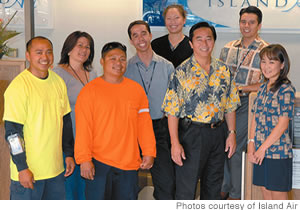Taking Off With Island Air

|
By Les Murashige
COO of Island Air
You haven’t heard much about Island Air since the price war began in 2006, but that doesn’t mean Island Air isn’t doing great things in the marketplace. Sure, we are like other airlines in that it is difficult to make a profit in such a volatile business environment, but you need to hear “the rest of the story.”
It is a rare opportunity to start up an independent airline. You can have a 40-year career in the industry and never get the chance. I was one of the lucky ones. It was a most difficult task for our management team, but it was also an opportunity of a lifetime given to very few airline professionals. So this was an exciting time for our team. As of May 11, 2004, we became independent from Aloha Airlines and began the task of building Island Air.
Building an airline, like anything in life, meant building relationships with our industry partners. It is virtually impossible to build an independent airline and truly stand alone. You must have the support of your industry partners to succeed. Aloha Airlines did a great job in supporting Island Air through this process.
One of our first steps was to establish our code-share and interline agreements. We established code-share partnerships with Aloha Airlines, Continental Airlines, Hawaiian Airlines and United Airlines. Most of these agreements allow Island Air’s code-share partners’frequent-flier program members to accrue and redeem miles on Island Air. The interline rate agreements helped build our relationships with other carriers serving Hawaii.
Island Air built its own web-site, which processes more than 50 percent of our bookings and allows for simple changes to flights and dates. Very few other airlines offer such conveniences on their web sites. We established relationships with the various reservations and faring systems so our flight schedule and fares could be distributed throughout the airline and travel industry system, and assembled our own reservations group.
An airline is only as strong as its base, which to Island Air means its employees. With today’s low unemployment, it is a challenge for small organizations to recruit, train and build a “passion” for our work. At Island Air, the employees are the heart of our organization and demonstrate their passion every day for what we do and how we do it.
Island Air chose surfing, the hula and Hawaiian music classic icons to showcase as tail designs on our aircraft. The three bright, colorful tail designs are Island Style (surfboard), Island Beauty (hula dancer) and Island Rhythm (ukulele). These designs represent Hawaii and who we are.
Island Air operates a fleet of six 37-seat DeHavilland Dash-8 aircraft. These turboprop planes are more economic for the short sectors we fly. The Dash-8 aircraft have earned a solid reputation for outstanding reliability and safety. Each aircraft features all leather seating, large overhead compartments, air conditioning and comfortable pressurized flights. They are ideal for high-frequency, short-haul routes that serve small community airports like those that Island Air services.
Today, an airline can do everything right but still struggle. There are so many external factors (i.e., fuel costs, terrorism) affecting the business that an airline doesn’t have control over. Even in this volatile business environment, Island Air is Hawaii’s leading regional carrier, serving eight destinations in the Islands. The airline now offers 444 weekly flights between the islands of Oahu (Honolulu International Airport), Maui (Kahului Airport and West Maui’s Kapalua Airport), Molokai (Ho’olehua Airport), Lanai (Lanai City Airport), Kauai (Lihue’s Airport) and the Island of Hawaii (Hilo International Airport and Kona International Airport). For reservations and flight information, visit www.islandair.com
E-mail this story | Print this page | Comments (0) | Archive | RSS Comments (0) |
Most Recent Comment(s):




 Del.icio.us
Del.icio.us








